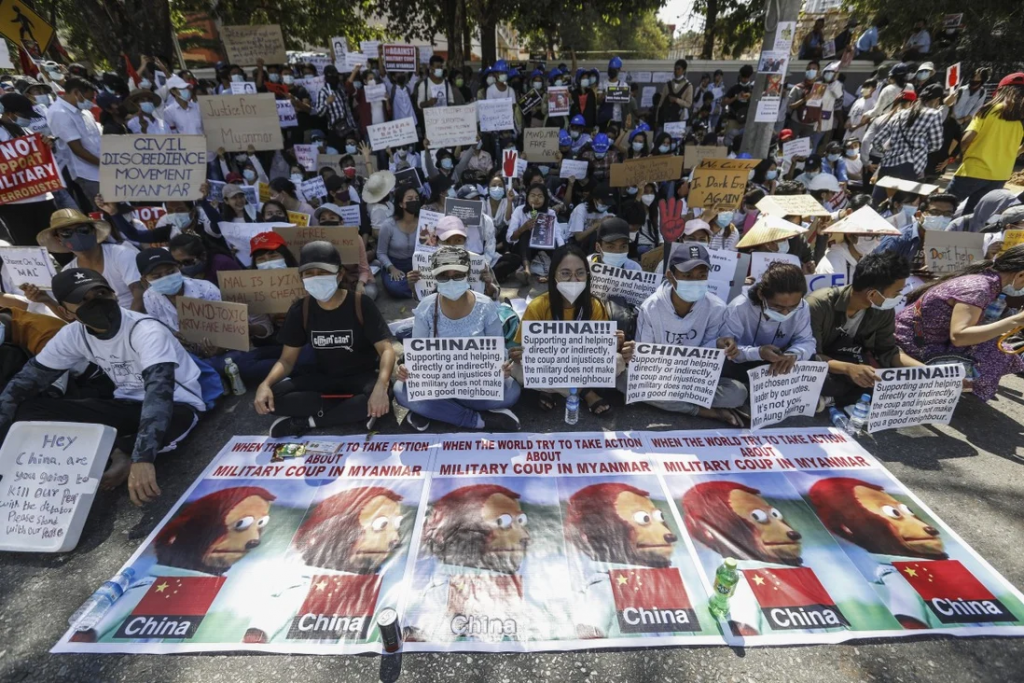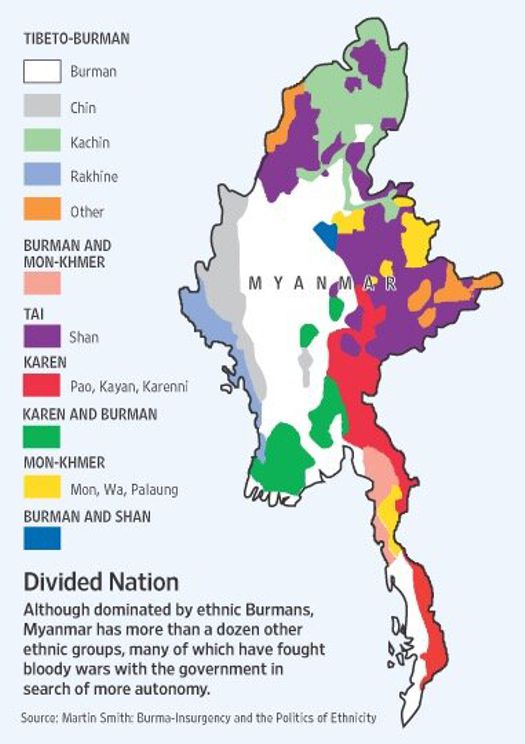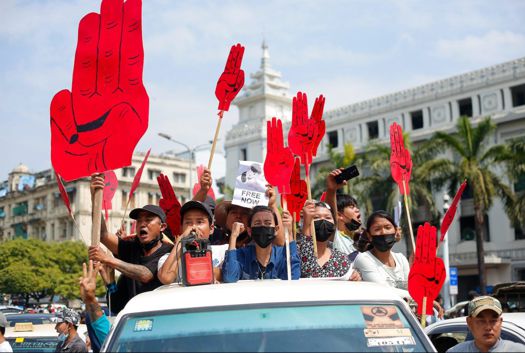Not even two weeks after Biden’s inauguration in the US, there was what was widely called a coup in Myanmar. In the first post on this blog regarding events there, I put forward the scenario that what was taking place was not your standard coup, but a ‘readjustment’ of sorts. Now there is little doubt as to what is happening in Myanmar: We are watching yet another attempt at a color revolution in that troubled land. Conspiracy? Chinese interference? Another military takeover? The Russians are behind it? Read on. But the violence taking place in Myanmar has an old familiar smell and the true colors of the belligerents are starting to show.
As the Western press is pitching this story, the troubles in Myanmar which started in February this year were simply an action by a disgruntled military, seeking to keep its muscle in government and subsequently going about its usual brutal suppression of Myanmar’s people. There is some truth in that. But there are other factors about which we neither recognize nor see reported.
Protests against the military takeover of the government at the 1st of February this year began soon thereafter. They were relatively peaceful compared to today until March. The Western press portrays Myanmar’s military as being fully supported by the Chinese and that Myanmar is under China’s hegemony. In fact, a spokesman for the Tatmadaw had said the military wanted to distance itself from China and move more toward the West, which would appear to put to rest the notion China was behind the military takeover. We don’t know if such a statement is a ruse to try to get sanctions on the military lifted, or if the statement is factual. The motive for the military takeover remains unclear. What is clear is that the situation in Myanmar will not become clarified any time soon. A government may take shape soon, but that hardly means Myanmar’s troubles would be over.
From the previous post on Myanmar, there was this:
“The situation in Myanmar will drag on, shown by the approaching direction of the Mars/Neptune midpoint to the nation’s Ascendant, Mar/Nep=Asc: “A weak and unstable person, a lack of vigour necessary for advancement in life. – The sharing of grief and sorrow with others, the termination of associations or unions.” So, stability and internal security is very likely to deteriorate in Myanmar in the coming months.”
That directed midpoint has only just come into orb and will be exact in a year-and-a-half. With the first post on Myanmar being written only days after the military takeover, and given there is a major Belt and Road project running through Myanmar, plus the timing of events, there were suspicions that all was not as it seemed on the surface regarding the parties involved or their motive. Time has proven those suspicions correct – hence the title of this post.
Violence has risen significantly in Myanmar since Mars went out-of-bounds in the last week of March. It will remain so for the remainder of April and the first part of May. We can expect violence to peak during that period and then to somewhat settle out. Since the violence started, over 700 Myanma have been killed on the civilian side, and 12 security forces. That is what is reported via the mainstream, anyway. But there is more to it.
The protests have been dubbed the ‘Spring Revolution’ by the local population. The Western press outlets are busy harping the usual line that China is behind the military crackdown. But that is where problems come into the narrative, that this is a simple military putsch. In fact, it is Aung San Suu Kyi and her government who had been drawing closer to China in recent months, inviting Chinese investment in Myanmar’s infrastructure. They actually have little choice, given geography. That is the cover story for why Aung San Suu Kyi was arrested and ousted from government. And now liberals across the world are clamouring for her release. This is where the story gets very interesting, convoluted and with any counter-narrative being branded as conspiracy theory in one way or another.
There is a video, worth watching to the end, that outlines what is really going on in Myanmar. It features Brian Berletic, an independent geopolitical analyst based in Thailand and ex-US Marine, who has had his finger on the pulse of events in Southeast Asia for years. The succinct synopsis of the video is that the reason the putsch on February 1st took place was to stop Aung San Suu Kyi’s government from expanding infrastructure and trade relations with China. This has Western backing and funding. And there is one reason in particular the Western powers want to destabilize Myanmar now – because of the aforementioned already existing BRI projects in Myanmar, with China having an eye toward their expansion.
There is a secondary reason for the violence we are seeing in Myanmar, and that is to keep the nation and the entire region destabilized in order to stop or curtail the expansion of the BRI and Chinese influence there as well as the possibility of establishing a UN military presence there. This has been an ongoing project for decades, and was one of the primary reasons for the Vietnam War, the latter outlined in the Pentagon Papers, specifically stated by J.T. McNaughton.
We won’t go over all the points of what is actually taking place in Myanmar. The cited video explains it all. Our interest here is in the astrology and a look at the timeline involved. Suffice it to say, the people of Myanmar, in all their factions, are being used, as we see in Ukraine against Russia for example, to ‘push back’ against China. But China is Myanmar’s huge neighbor to the north. If trade is disrupted between the two nations it is the people of Myanmar who will suffer the most.
It is pointless to side with either the military or the protesters in the ongoing conflict in Myanmar, as they are being played against each other. And when it comes to the protesters and minority ethnic groups in Myanmar, these aren’t exactly what one would call ‘liberal’ people. There are strong strains of racism and a long history of violence between them, differences which had been gamed by the British when they occupied what was then Burma as a tool to control the country. What is plain to see now is that events in Myanmar have little to do with ‘democracy’ or human rights. What does the astrology indicate, then?
There is one notable direction by a midpoint to Myanmar’s Pluto, the latter ruling Myanmar’s 12th house (foreign/secret enemies of the state), Mars/Saturn=Pluto: “Brutality, the rage or fury of destruction. – The intervening of Higher Power, bodily injury or harm (murder, the death of a great many people).” That direction will be exact in seven months, and Pluto is in the 9th house of the chart – foreign trade and foreign actors. That direction basically tells the story of Myanmar in the present day – foreign interference in Myanmar’s affairs to the detriment of the nation, with the purpose being to disrupt trade and economic relations with another foreign power.
There is a hierarchy of aims with events in Myanmar. The primary aim is to stop any further trade with China. Chinese businesses are being attacked and burned in Myanmar now. The Chinese are fully aware of what is taking place. China has consistently called for calm and dialog between the various factions. If that fails, then the next step in escalation would be a violent civil conflict that would render the nation unfit for any investment. That is currently in development.
Along with the directed midpoint just described, the transits in the first part of July this year look to be particularly violent in Myanmar, with the transit Ura=Mars/Saturn, all three also activating the aforementioned direction. This combination of factors appears to signal a collapse of the state, at least temporarily, or a foreign intervention. Such an intervention could be by Western powers or by Eastern powers (including Russia), or a combination of both. In other words, the latter would be another proxy conflict. Protesters are calling for the UN to invoke R2P – ‘Responsibility to Protect’, as was used in the Balkans and Libya, both of which resulted in failed states. There is clearly foreign influence behind both the protests and the military takeover.
The anti-China component in the violence and general restiveness is shown in the burning of Chinese businesses, calls for ‘burning the Chinese pipeline’, the one shown in the post on the Feb 1st takeover, arming of minority groups on China’s borders and Western reporting of China’s alleged support for the military, even that China had helped in the military takeover. China has denied any involvement and says it has good relations with both Suu Kyi’s government and the military. And to top off the anti-China element, we have the following picture, below (bigger):

Unless I miss my guess, English is not the mother tongue in Myanmar. Photos like the above are staged for national and international consumption and by all appearances are produced by Western interests. The opposition groups in Myanmar want the West to intervene. That is far less likely to happen these days than would have been the case a decade ago, given the proximity to China.
The United States wrote the book of destabilizing nations (see also this video) and color revolutions, or to be specific, one man wrote the book, which is commonly circulated around opposition groups across the world. That man was Gene Sharp, From Dictatorship to Democracy.
Myanmar is a divided society and is certainly not monolithic. There are ancient ethnic and racial hatreds that run through various groups. Those groups, mapped out, can be seen below:

There have been several bloody conflicts between some of the ethnic groups and the Myanmar government since 1995, as shown below, noting the economic and energy corridor runs through a few of the areas where conflict has taken place.

Those ethnic groups comprise just over 30% of the total population, and they have been largely left out of government and have been discriminated against by the ethnic Burma, who rule the country. There is not going to be any easy solution to the present crisis. And the government has no effective media to counter the Western NGOs who are funding and pushing much of the protest, even as those same NGOs more than likely prompted the military to take action in the first place.
Looking at the total picture, as much as can be surmised, Myanmar looks to be unsettled for some time. And if that turns out to be the case, the Western powers would be quite happy to let it go on, much as they would decry the violence, so long as it runs Chinese business out of Myanmar and at least temporarily disrupts the economic corridor, if not the pipeline, too. And sanctions against the military will only enable the disruption of Myanmar as a functioning state.
If you want any further support in evidence that the events in Myanmar amount to a color revolution, there are now mounting calls and support for a parallel parliament and for the constitution to be rewritten. We recall Venezuela and international support in the West for one Juan Guaidò, which has since fallen into disgrace. Such a new constitution would favor ethnic minorities and remove the military from its current level of say in the government. We might fully expect the Western powers to recognize such a contrived parliament should the violence see matters turn in favor of the Tatmadaw.
On top of the parallel government we see reporting of a possible ‘Russian connection’ to the Myanmar military, with reports of Russian aircraft being used to suppress ethnic violence in support of the protests. Such reporting ignores the fact the Russians have no involvement in the Myanmar crisis. But they do support China. China for its part supports stability and has worked with both the military and Aung San Suu Kyi’s government.
The mainstream press is not giving us an accurate accounting about events in Myanmar. There is much more to this than ‘a fight for democracy’. India is involved in the fracas there, too, as a member of the Quad. The truth will be more fully known as the months unfold, but there is definitely foreign involvement and encouragement of the violence in Myanmar.
Featured pic from Asia Times

